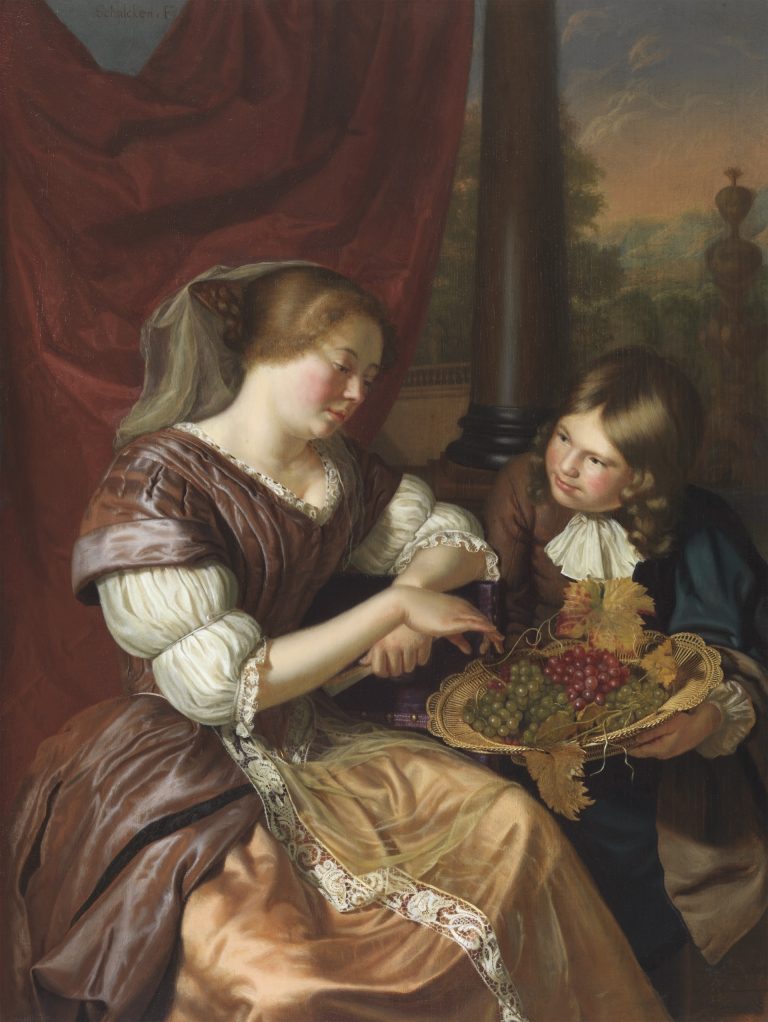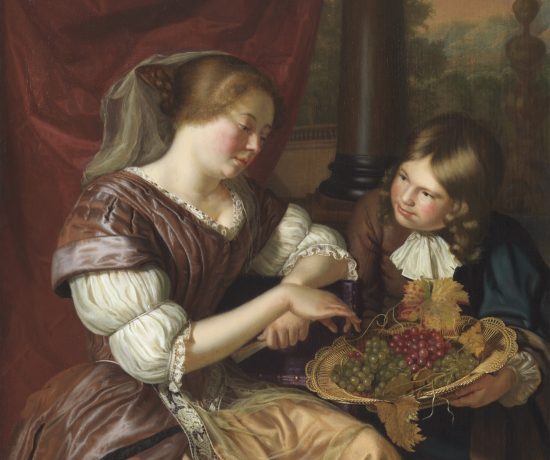This painting, which has always been attributed to Godefridus Schalcken (1643–1706), shows a young woman in sumptuous dress, sitting in front of a red curtain and seen from the knees upward. In her left hand she holds a closed fan, while reaching out with her right hand toward a bunch of grapes in a large wicker basket filled with white, red and blue bunches of this delicacy, which a boy offers her. In the right background is a view of a walled garden with an impressive fountain and tall trees, beyond which high mountains rise. The signature “Schalcken . F” at the upper left appears in a piece of blue sky where the curtain sags. Not only is this a rather unusual place for Godefridus Schalcken to have put his signature, but the absence of his first initial, G, is certainly uncommon.
A comparison of this painting with works considered typical of Schalcken reveals additional anomalies. The detailing of the woman’s clothing and particularly the wicker basket is somewhat hard and lacks the soft touch we expect to see from this master. The anatomy of the boy’s head is not entirely correct, and a background landscape with a mountainous vista appears nowhere else in Schalcken’s oeuvre. The painting therefore seems to have been produced in Schalcken’s studio by a pupil or an assistant.
The attribution of the painting can be pinpointed more exactly thanks to the capital F in the signature. This signature, as well as its placement, is identical to that on Maria Schalcken’s Self-Portrait at the Easel, now in the Van Otterloo collection (fig 1).1 Though Godefridus occasionally placed an F after his name as an abbreviation for fecit, he did so using a small S-like letter.2 On Self-Portrait at the Easel, not only did Maria sign her name in full, but she also wrote the same capital F we find on the present painting. The space in front of the signature on Boy Offering Grapes to a Woman is, moreover, large enough to have accommodated Maria’s Christian name. Thus it is reasonable to assume that it was not Godefridus, but rather Maria—his sister and pupil (and junior by several years)—who painted Boy Offering Grapes to a Woman, even if her brushstrokes are somewhat broader and less accomplished than in her Self-Portrait at the Easel. The absence of Maria’s Christian name in the signature could then be blamed on a former owner, who evidently thought it might prove more profitable to let it pass for a work by Godefridus.
Maria Schalcken presumably studied with her brother from 1665 to 1670, after he had completed his training in Gerrit Dou’s studio and returned from Leiden to Dordrecht, where he moved back in with his parents in the Nieuwstraat (see GS-101).3 She thus became Godefridus’s first pupil (see GS-106). A century and a half ago, her work had already been described by Immerzeel as rare.4 Her painting career cannot have lasted very long, and she would never have had to paint for a living. It is likely that after her marriage in 1682 to the Dordrecht merchant Severijn van Bracht (b. 1658), she never touched her brushes again, because one year later she gave birth to a daughter, Anna, and in 1685 to a son, Cornelis.5 Van Bracht had his banns read again in July 1700, so by then he must have been a widower and Maria must have died some time before that. Therefore, Maria’s painting activities should be placed mainly in the 1670s.6
In addition to Self-Portrait at the Easel, there is one other known painting by Maria’s hand, Interior with a Young Lady Seated, Powdering Her Hair, a small panel documented in 1979 in the London art trade.7 Furthermore, there are a number of listings of paintings by her in old sale catalogues. These refer to two genre pieces, Woman at Her Toilet, Eating Comfits (Een Vrouwtje dat voor haar Toilet sit Confituuren eetende) and Drunken Woman and a Young Boy in a Room (Een dronk Wyf en een Jongetje in een Vertrek), as well as the aforementioned Young Lady Seated.8

